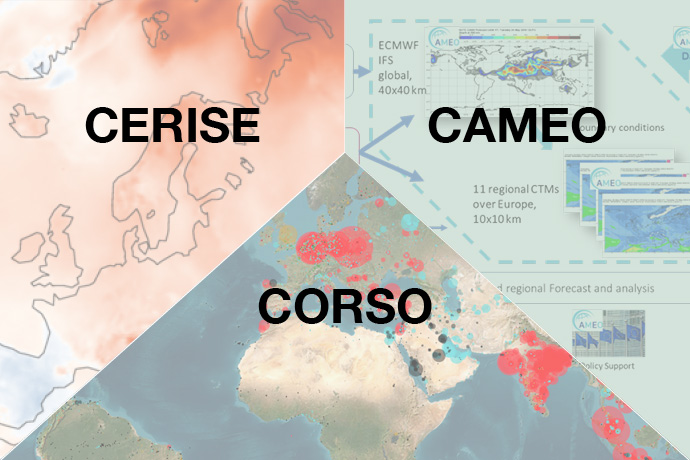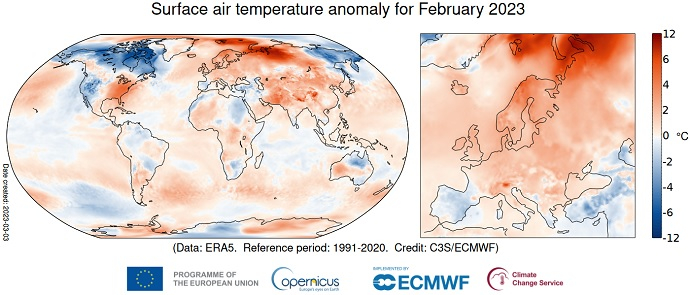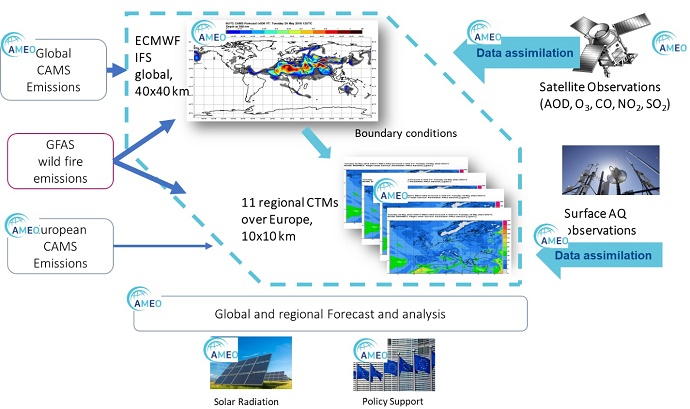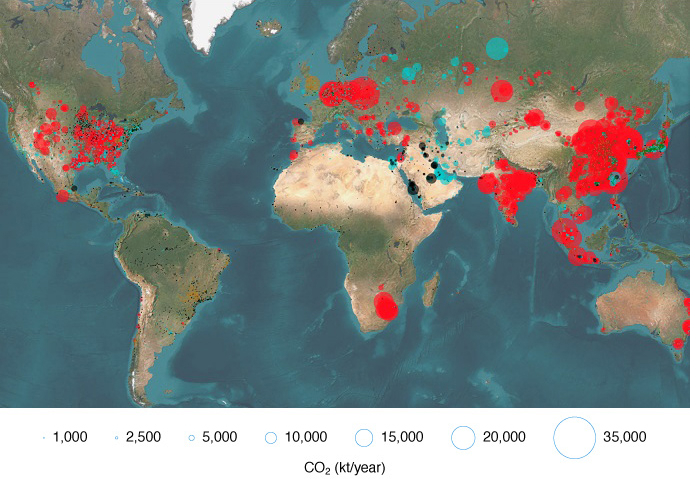

January 2023 marked the start of three EU-funded research projects to further develop the EU’s Copernicus Climate Change Service (C3S) and Copernicus Atmosphere Monitoring Service (CAMS) implemented by ECMWF.
CERISE aims to enhance the quality of C3S climate reanalyses and seasonal forecast products.
CAMEO will improve the service provided by CAMS by preparing for the uptake of new satellite data and providing uncertainty information for a range of CAMS products.
And CORSO will help to build an observation-based anthropogenic CO2 emissions Monitoring and Verification Support capacity (CO2MVS), which will be run by CAMS.
The three projects are all coordinated by ECMWF. They have a combined budget of 24 m euros and bring together between 12 and 22 partners.
CERISE
The aim of this four-year project is to improve the quality of future C3S climate reanalyses and seasonal prediction products, with a focus on land–atmosphere coupling.
C3S currently provides several reanalysis products. Among them are ECMWF’s ERA5 global weather and climate reanalysis from 1940 to the present, the ERA5-Land dataset to provide hourly high-resolution information on surface variables, and the regional reanalysis CARRA2 (Copernicus Arctic Regional Reanalysis, second generation).
C3S also provides seasonal prediction products based on ensemble forecasts from several operational systems. Reanalyses and seasonal forecasting activities are strongly linked as seasonal prediction systems rely on reanalyses for initialisation, verification and calibration.
CERISE will develop new and innovative coupled land–atmosphere data assimilation approaches and land surface initialisation techniques to pave the way for the next generations of C3S global and regional reanalyses and seasonal prediction systems.
These developments will be combined with innovative work to enhance the exploitation of Earth system observations over land surfaces.
CERISE will also provide the proof of concept and innovative diagnostic tools to demonstrate the feasibility of the integration of the developed approaches in the core C3S operational service.
“The diagnostic tools, prediction skill metrics, and prototypes developed through CERISE are expected to impact directly on the quality of C3S reanalysis and on the skill of its seasonal forecasting products, meeting the demands of a constantly evolving user community,” said C3S Director Carlo Buontempo.

The results of reanalyses are shown on a monthly and yearly basis in climate bulletins on the C3S website. Credit: Copernicus Climate Change Service/ECMWF.
CAMEO
This three-year project aims to improve CAMS services on monitoring and forecasting the composition of the Earth’s atmosphere.
In particular, it will help to prepare global and regional models used by CAMS for forthcoming satellite data. These include data from the Sentinel-4 and Sentinel-5 missions and the 3MI instrument aboard the Metop Second Generation mission.
3MI will provide novel observations on aerosol properties, and Sentinel-4 will monitor European air quality at much higher temporal resolution than is currently possible.
CAMEO will also advance the methods used for aerosol and trace gas data assimilation and, through a process called inversion, it will aim to improve surface fluxes of biogenic emissions. This will help to improve the accuracy of CAMS analyses as well as global and regional forecasts.
Finally, CAMEO will develop methods to provide uncertainty information for CAMS emission products as well as policy support, solar radiation and deposition products. Specifically, the ECMWF ensemble forecasting system will be applied to better understand the impact of meteorological forecast errors on global air quality forecasts.

Overview of the CAMS data production chain. Elements marked ‘CAMEO’ will be further improved by the project.
CORSO
For countries to assess progress towards their carbon dioxide (CO2) reduction targets under the Paris Agreement, they will have to monitor and verify anthropogenic CO2 emissions in a consistent and reliable manner. The CO2MVS capacity, under development by CAMS, will enable users to specify the share of emissions resulting from human activity.
The CO2 Human Emissions (CHE) and CoCO2 projects have already set the stage for this plan, and the three-year CORSO project will take it to the next level.
CORSO will further improve the tools needed to optimally monitor CO2 emissions globally and locally by improving the use of observations of co-emitted species, such as nitrogen oxides (NOx) and carbon monoxide (CO), and their emission ratios. This will lead to more accurate estimates of anthropogenic CO2 emissions.
The project will also explore the added value of observations of radiocarbon (14CO2) and atmospheric potential oxygen (APO) to better separate the impact of fossil fuel emissions and biospheric fluxes on atmospheric CO2 concentrations.
Finally, the project will improve the use of satellite observations of the land surface to improve our estimates of biogenic CO2 fluxes.
"The CAMEO and CORSO projects are pivotal, as they will enhance the quality and the accuracy of our products using the strong expertise from all project partners. We are confident that the results of these projects will have a profound impact on CAMS and its ability to support policy-makers, businesses, and citizens," said CAMS Director Vincent-Henri Peuch.

Plant-level CO2 annual emissions as reported by the CoCO2 global power plant source database. Emissions are colour-classified according to the main fuel used: coal (red), natural gas (blue), oil (black), waste (green) and biomass (brown). This new point source database will be further improved for CO2 and co-emitted species in the CORSO project. Credit: Marc Guevara (BSC).
Further information
More details on the three projects can be found on the C3S website.

The CORSO project (grant agreement No. 101082194), the CAMEO project (grant agreement No. 101082125), and the CERISE project (grant agreement No. 101082139) are all funded by the European Union. Views and opinions expressed are, however, those of the authors only and do not necessarily reflect those of the European Union or the Commission. Neither the European Union nor the granting authority can be held responsible for them.
